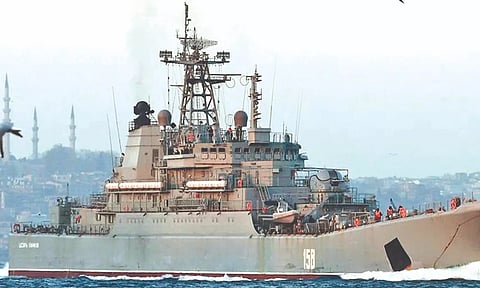

By Thomas Latschan
KIEV: The Russian warship Caesar Kunikov (pictured) had been in several conflict situations throughout its commission, including being deployed off the coast of Syria during Russia’s 2008 war in Georgia. But on Wednesday night, the Ukrainian army announced on Telegram that the 112-meter (367-foot) warship had been sunk off the coast of the Crimean peninsula. Ukraine’s intelligence services released a video of the incident in which an explosion is followed by a raging fire onboard the vessel.
The sinking was certainly not Ukraine’s first military success on the Black Sea, a crucial battleground in its war against Russia. Whereas both sides are fighting to a standstill on land, Ukraine has been able to break Russia’s naval supremacy at sea.
That is not how things looked when Russia launched its full-scale invasion of Ukraine in February 2022. The numbers suggested that Russia held a massive military advantage over its neighbour. Its Black Sea Fleet quickly sealed off Ukraine’s harbours, captured strategically important Snake Island off the coast of Romania and mined large swaths of the sea, seemingly cutting Ukraine off from the rest of the world. But little by little, Ukraine has freed itself from Russia’s naval chokehold. The first step came in April 2022, with the sinking of the Moskva, the flagship of the Russian Black Sea Fleet. Then came the recapture of Snake Island in July of 2022. Russian ships, ports and supply routes were routinely attacked.
In July 2023, Ukraine attacked the Kerch Bridge, which connects the occupied Crimean peninsula to mainland Russia, leaving it badly damaged.
In October 2023, Russia was ultimately forced to withdraw most of its fleet from Sevastopol into the Black Sea’s eastern waters. Yet even there, their warships remain vulnerable, as was seen when Ukraine was able to badly damage a landing craft in the port of Novorossiysk some 300 kilometers (186 miles) east of Sevastopol.
Ukraine’s successes “show that the Russians can’t adequately protect themselves against Ukraine’s anti-ship and drone artillery,” said Stephen Blank, Eurasia analyst at the Washington-based Foreign Policy Research Institute, in a September 2023 interview with DW. “More than that, they don’t seem capable of answering the threat Ukraine poses to them.”
Statistics from the Center for Strategic and International Studies (CSIS), a Washington think tank, show Russia has lost around 40% of its Black Sea naval tonnage since February 2022, wrote retired US Marine officer and CSIS senior advisor Mark Cancian in a guest commentary published in Foreign Affairs magazine earlier this month. But how was that possible?
Ukraine achieved these military victories with an unusual combination of weapons, Cancian wrote. Part of its arsenal consists of anti-ship missiles — some produced domestically, others provided by Western allies — with a range of up to 200 kilometers. These were designed to be launched at sea, but the Ukrainian army has modified them to be fired from protected areas on land, making them less vulnerable to counterattack.
Ukraine has also been effectively using another type of long-range missile provided by Western allies to attack moving targets at sea, even though it is designed for attacking static targets on land. Ports, logistics centers and supply depots in Crimea have all been hit with them, as well as warships anchored in Russian ports.